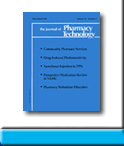 |
 |
PROBABLE
NAFCILLIN-WARFARIN INTERACTION
Anne M Baciewicz, Anne M
Heugel, and Peter G Rose
To request full article click here.
OBJECTIVE: To report a case of probable nafcillin-warfarin interaction and to discuss the occurrence of this event.
CASE SUMMARY: A 74-year-old white woman with stage IV ovarian cancer was given warfarin and nafcillin concurrently for a subclavian venous thrombus and an infected subclavian mediport. After 10 days of therapy, the patient's prothrombin time remained within the range of 11.6-13.8 seconds (control range 10.4-12.8). Her international normalized ratio (INR) ranged from 1.0 to 1.45 and her activated partial thromboplastin time ranged from 49 to 80 seconds (22-34). Nafcillin was discontinued. Continuous intravenous heparin was continued, and the patient was given warfarin 10 mg po for four days. A maintenance regimen of warfarin 5 mg po daily was then initiated. Within seven days of discontinuing nafcillin, the INR increased from 1.08 to 2.10.
DISCUSSION: Several cases of nafcillin-warfarin interaction have been reported in the literature. The case reported here is similar to a previously reported one in which a lower dose of nafcillin (6 g/d) was used for a short time (10 d). Therapeutic warfarin doses were started simultaneously with nafcillin. The interaction usually occurs within three to 10 days and abates within one to eight weeks. The postulated mechanism of interaction is induction of hepatic microsomal enzymes by nafcillin, leading to warfarin resistance.
CONCLUSIONS: When nafcillin is prescribed concomitantly with warfarin, high doses of warfarin are usually required and close monitoring is necessary to keep the patient's INR within a designated range. Clinicians should be aware of a potential nafcillin-warfarin interaction because warfarin has a narrow therapeutic window that may readily lead to therapeutic failure or toxicity. Frequent review of clinical signs and symptoms of bleeding or thromboembolism and warfarin dosage adjustment are necessary if both drugs are used concurrently, and also when nafcillin is discontinued.
J Pharm Technol 1999;15:5-7.
To order the complete CE article click here.
To request full article click here.
|
|
|
||
|

